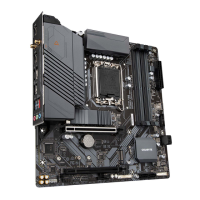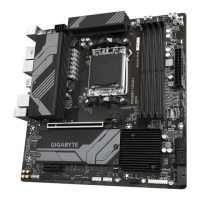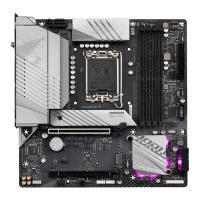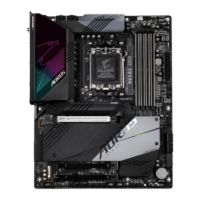B. Rebuilding an Array
Rebuildingistheprocessofrestoringdatatoaharddrivefromotherdrivesinthearray.Rebuildingappliesonly
tofault-tolerantarrayssuchasRAID1,RAID5orRAID10arrays.Theproceduresbelowassumeanewdrive
isaddedtoreplaceafaileddrivetorebuildaRAID1array.(Note:Thenewdrivemusthaveequalorgreater
capacity than the old one.)
Turnoffyourcomputerandreplacethefailedharddrivewithanewone.Restartyourcomputer.Whileinthe
operating system, launch the Intel
®
Optane
™
Memory and Storage Management utility from the Start menu.
1. Go to the Manage menu and click Rebuild to another disk in Manage Volume.
2. SelectanewdrivetorebuildtheRAIDandclickRebuild.
3. The Statusitemontherightofthescreendisplaystherebuildprogress.AftertheRAID1volumerebuilding,
the Status will display as Normal.
A-2. Installation Guidelines
1. Go to Settings\IO Ports\SATAAndRST Conguration and make sure RST Control PCIe Storage
Devices is set to Manual. Then depending on which M.2 connector you install the Optane
™
memory in, set
the corresponding PCIe Storage Dev on Port XX item to RST Controlled.
2. After re-entering the operating system, launch the Intel
®
Optane
™
Memory and Storage Management
application from the Start menu. If you install more than one Optane
™
memory, please select which one
you are going to use. Then select which drive to be accelerated. Click Enable Intel
®
Optane
™
Memory. All
data on the Optane
™
memory will be erased. Make sure you back up the data before continuing. Follow the
on-screen instructions to proceed. When completed, restart the system.
3. Launch the Intel
®
Optane
™
Memory and Storage Management application from the Start menu and make
sure the Intel
®
Optane
™
Memory has been enabled.
4. Ifyouwanttoacceleratethesystemdrive,youcanselectspecicfolders,les,orapplicationstoaccelerate
using the Intel
®
Optane
™
Memory Pinning function. (The Optane
™
memory used must have at least
32 GB capacity.)
• An Optane
™
memorycannotbeusedtoaccelerateanM.2PCIeSSD.
• If more than one Optane
™
memory is installed, you can select only one of them to accelerate
your SATA-based boot drive. The other(s) can only be used as data drive(s).
• DonotabruptlyremovetheOptane
™
memory.Doingsowillcausetheoperatingsystemtostop
functioning correctly.
• If you want to change/remove the Optane
™
memory, you must disable it using the Intel
®
Optane
™
Memory and Storage Managementapplicationrst.
• After enabling the Optane
™
memory, the related BIOS settings will remain even after a BIOS
update.
- 46 -

